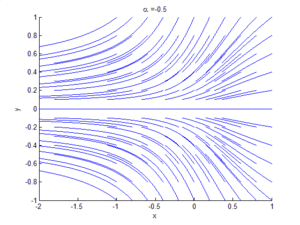
Back نظرية التشعب Arabic Bifurcació (matemàtiques) Catalan Bifurkation (Mathematik) German Bifurcación (matemática) Spanish Bifurkatsioon (matemaatika) Estonian نظریه دوشاخگی Persian Bifurkaatio (kaaosteoria) Finnish Théorie des bifurcations French תורת הביפורקציה HE Bifurkációelmélet Hungarian

Bifurcation theory is the mathematical study of changes in the qualitative or topological structure of a given family of curves, such as the integral curves of a family of vector fields, and the solutions of a family of differential equations. Most commonly applied to the mathematical study of dynamical systems, a bifurcation occurs when a small smooth change made to the parameter values (the bifurcation parameters) of a system causes a sudden 'qualitative' or topological change in its behavior.[1] Bifurcations occur in both continuous systems (described by ordinary, delay or partial differential equations) and discrete systems (described by maps).
The name "bifurcation" was first introduced by Henri Poincaré in 1885 in the first paper in mathematics showing such a behavior.[2]
- ^ Blanchard, P.; Devaney, R. L.; Hall, G. R. (2006). Differential Equations. London: Thompson. pp. 96–111. ISBN 978-0-495-01265-8.
- ^ Henri Poincaré. "L'Équilibre d'une masse fluide animée d'un mouvement de rotation". Acta Mathematica, vol.7, pp. 259-380, Sept 1885.
© MMXXIII Rich X Search. We shall prevail. All rights reserved. Rich X Search